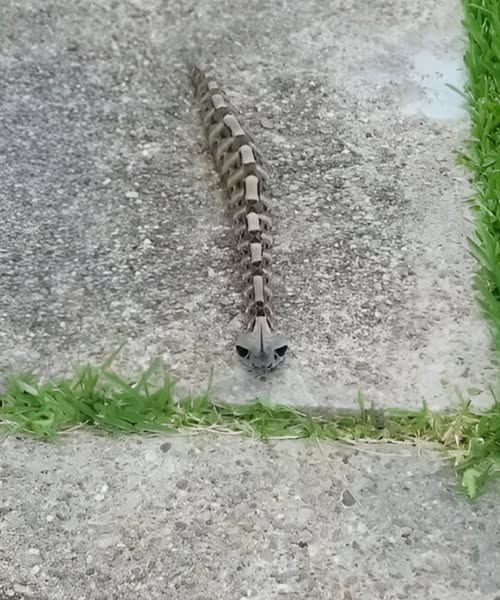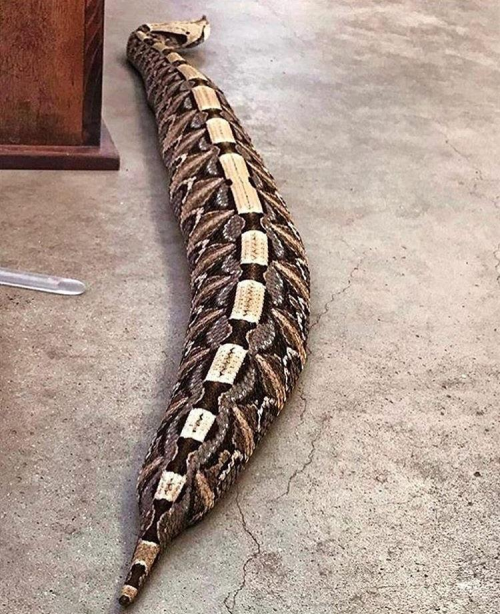Ever felt like the forest floor was watching you? That eerie sensation might just be more real than you think—especially if you’re in sub-Saharan Africa. Imagine stepping on what looks like a pile of dried leaves… and it suddenly moves. That’s not your imagination. It’s a Gaboon viper—possibly the most deceptive and dangerous snake on Earth.
With leaf-patterned skin that blends into its surroundings, the Gaboon viper is nature’s ambush artist. Its venom is powerful enough to drop large mammals in seconds. Its fangs? The longest of any snake alive. And yet, most people have never even heard of it.
Let’s dive into the chilling world of this mysterious predator and uncover why it’s as fascinating as it is fearsome.

The Ultimate Camouflage Expert
The Gaboon viper doesn’t just blend in—it vanishes. Its intricate skin patterns mimic forest debris so precisely that even trained biologists can miss it. If this snake were an artist, it would specialize in vanishing acts. But make no mistake: just because you can’t see it doesn’t mean it can’t strike.
These snakes love the rainforest floor, especially areas littered with leaves and low brush. They lie still for hours—or even days—waiting for the perfect moment. One sudden strike, and dinner is served.
Video: The snake you DONT want to see
What Makes the Gaboon Viper So Deadly?
If there was a snake Olympics, the Gaboon viper would win gold in a few events. Let’s break down the reasons it’s earned its lethal reputation:
- Longest Fangs in the World: Measuring up to 2 inches long, their fangs can pierce deep into flesh, even through tough skin or light clothing.
- Massive Size: These aren’t skinny snakes. They can stretch over 6 feet long and weigh more than 45 pounds—making them the heaviest vipers in Africa.
- Venom Power: One bite delivers a massive dose of cytotoxic venom that breaks down cells, causes intense swelling, and destroys tissue.
- Silent Ambush Hunter: They strike without warning and rarely miss.
Unlike many snakes that flee when approached, the Gaboon viper stays put. That’s part of the danger—you won’t know it’s there until it’s too late.
Real-Life Horror Story: 44 Doses of Anti-Venom
Let’s talk about the time a North Carolina man nearly didn’t live to tell his tale. He was bitten by his pet Gaboon viper—yes, someone thought keeping one at home was a good idea—and was rushed to the hospital. Doctors administered 44 doses of anti-venom, a record-breaking quantity. He survived, but only after losing two fingers.
Now imagine if that anti-venom hadn’t been available. That’s not just a bad day—it’s a fatal one.
Gaboon Viper Behavior: Deadly But Not Aggressive

Here’s the twist: Gaboon vipers aren’t aggressive. In fact, they’re surprisingly calm. They don’t go looking for a fight. Most bites happen because someone steps on them by accident.
When threatened, they’ll lift their heads, let out a deep hiss, and try to warn you. But if you ignore that warning? You’ll be on the wrong end of the most precise strike in the reptile world.
They prefer to hunt at night, going after birds, rodents, and other small mammals. And they don’t chase. They just wait. Quietly. Patiently. Deadly.
Another Emergency: A Virginia Snake Incident
Shortly after the North Carolina scare, another Gaboon viper bite rocked the news—this time in Virginia. The victim was another exotic pet owner. The bite triggered a medical scramble, with anti-venom rushed in from multiple zoos, including the Virginia Aquarium and the Smithsonian National Zoo.
Think about that. Emergency teams had to rely on zoological facilities just to save this guy’s life. Your average ER isn’t equipped to deal with a bite from a snake like this.
Why on Earth Would Anyone Keep One as a Pet?
It’s a fair question, right? The short answer: fascination. Some reptile lovers are drawn to the rarity and beauty of exotic species. But fascination doesn’t equal responsibility.
Gaboon vipers aren’t house pets. They’re high-risk predators that require extreme care, professional-grade enclosures, and immediate access to specialized medical support. One careless moment, and it’s game over.
Worse yet, most cities and towns don’t stock anti-venom for African vipers. You’re depending on rare resources—and timing—to survive a bite. That’s not a gamble most people should ever take.
Separating Snake Myth from Snake Reality
Video: Gaboon viper moves like a caterpillar
Here’s something that needs to be said: not all snakes are evil villains waiting to attack. In fact, the majority of snakes are harmless and play a vital role in controlling pests like rats and insects.
Most bites happen because humans get too close, too fast, or step where they shouldn’t. And while Hollywood loves to show venomous snakes as aggressive, most real-life species—including the Gaboon viper—avoid confrontation.
The best advice? If you see a snake, back away slowly. Don’t poke it. Don’t try to be a hero. Just give it space and respect.
Respect Nature’s Design, Don’t Try to Own It
Nature created the Gaboon viper for one thing: survival. And it excels at it. From its leaf-patterned camouflage to its lightning-fast strike, everything about this animal screams perfection.
But that doesn’t mean it belongs in a suburban living room. Admire it in documentaries, observe it at zoos, and marvel at its evolutionary brilliance—from a safe distance.
Because sometimes, the most beautiful things in nature come with a price. And the Gaboon viper? It demands respect—or else.
Conclusion: Beauty, Danger, and a Warning From Nature
The Gaboon viper is a creature of mystery, elegance, and unrelenting danger. With a design fine-tuned by evolution and a venomous bite that leaves no room for error, it’s the snake you never want to cross paths with—and likely never will unless you’re extremely unlucky.
So what’s the final takeaway? It’s simple. Don’t mess with nature’s masterpiece. Whether you’re trekking through a rainforest or scrolling past a YouTube video of this incredible snake, remember: the Gaboon viper doesn’t need your admiration up close. Respect it from afar. And count yourself lucky that it prefers silence over strikes.


